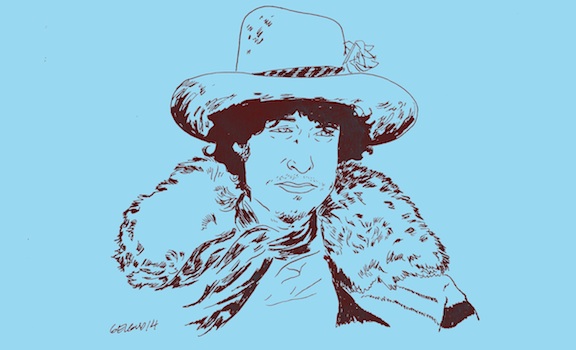The Evolution of Bob Dylan, Or, To Thine Own Many Selves Be True
By Nathan Gelgud

Bob Dylan by Nathan Gelgud, 2014.
A couple weeks ago, I ran into a friend who’d just watched "I’m Not There," Todd Haynes’s 2007 movie about Bob Dylan. He was thoroughly annoyed by the movie, in which Dylan is portrayed variously (albeit under different character names) by Cate Blanchett, Christian Bale, and Heath Ledger, among other actors. I defended the movie, but I see the problem. "I’m Not There" is driven by a tone of "watch-me-do-this," and it thinks that the stunt of using different actors is unusual or jarring. In fact, it’s the opposite. It’s entirely too on the nose. This is the obvious way to do a Dylan movie. Haynes doesn't need to underline Dylan’s fractured identity -- Dylan himself has been doing it his whole life.
Dennis McDougal makes this a running theme in his new biography of Dylan, which is available in paperback this week. First he was chubby-faced Bobby Zimmerman, or Zimbo, a kid who "dressed like a nerd before there was such a term." Then he was a teen iconoclast making himself over in the image of James Dean. Later, he wanted to be Woody Guthrie. Then he was a rock icon jaded by the over-earnestness of the folk scene. He refused to give straight answers to stock questions from reporters and talk show hosts. Was he gaming the system, exposing a vapid publicity machine, or was he just a spoiled brat who didn’t appreciate his own success?
Eventually, he was a chronicler of his own life. But that was the rockiest territory of all: recent allegations have it that Dylan’s autobiography is cobbled together from copious other sources and has a tenuous connection to real events. Even the most overt manipulation of identity, Bob’s name change from Zimmerman to Dylan, turns out to be muddled. It’s probably an homage to Welsh poet Dylan Thomas, but Bob Dylan claims he pulled it out of thin air.
McDougal’s book navigates this territory with calm precision, focusing on the idea that through all his identity changes, and the convoluted provenance of some of his sources and inspirations, Dylan was a genius at reinventing himself and a lot of the music that he’s touched. He reinvented himself as he reinvented and invigorated the era. Early on, McDougal focuses on Dylan’s deliberate statement that as a young folk singer, he was "building a character that will sell." This alienated some of his fellow troubadours on the do-gooder Greenwich Village coffee shop circuit, but it illustrates that the rock icon has never had delusions about his own poses. Though McDougal’s approach to Dylan has almost nothing in common with that of filmmaker Haynes, the book makes a great complement to the movie, with the film celebrating and interpreting Dylan’s various identities, and McDougal’s book explaining their evolution and context.
To purchase the original drawings used for Nathan Gelgud’s Biographile posts, visit his Etsy page.
